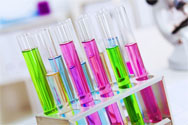您的位置:首页 > 新闻中心 > 全球化学品统一分类和标签制度(GHS)危险说明编码

全球化学品统一分类和标签制度(GHS)危险说明编码
2018.05.14 点击36875次
危险说明是全球化学品统一分类和标签制度(全球统一制度)【GLOBALLY HARMONIZED SYSTEM OF CLASSIFICATION AND LABELLING OF CHEMICALS (GHS)】的一部分。 他们的目的是形成一套可以翻译成不同语言的有关化学物质或混合物危害的标准化短语。每个危险说明被设计成一个代码,以字母H开头,接着是3个数字。对应相关危害的说明通过代码共同组成,所以代码并不连续。代码用作参考,例如帮助翻译,但是应该出现在标签和安全数据表上。
危险说明分为三部分,即:物理危险、健康危险和环境危险。
| 代码 | 危险说明 |
| 物理危险 | |
| H200 | Unstable explosive 不稳定爆炸物 |
| H201 | Explosive; mass explosion hazard 爆炸物;整体爆炸危险 |
| H202 | Explosive; severe projection hazard 爆炸物;严重迸射危险 |
| H203 | Explosive; fire, blast or projection hazard 爆炸物;起火、爆炸或迸射危险 |
| H204 | Fire or projection hazard 起火或迸射危险 |
| H205 | May mass explode in fire 遇火可能整体爆炸 |
| H206 | Fire, blast or projection hazard; increased risk of explosion if desensitizing agent is reduced 起火、爆炸或迸射危险;退敏剂减少时爆炸风险增加 |
| H207 | Fire or projection hazard; increased risk of explosion if desensitizing agent is reduced 起火或迸射危险;退敏剂减少时爆炸风险增加 |
| H208 | Fire hazard; increased risk of explosion if desensitizing agent is reduced 起火危险;退敏剂减少时爆炸风险增加 |
| H220 | Extremely flammable gas 极其易燃气体 |
| H221 | Flammable gas 易燃气体 |
| H222 | Extremely flammable aerosol 极其易燃气雾剂 |
| H223 | Flammable aerosol 易燃气雾剂 |
| H224 | Extremely flammable liquid and vapour 极其易燃液体和蒸气 |
| H225 | Highly flammable liquid and vapour 高度易燃液体和蒸气 |
| H226 | Flammable liquid and vapour 易燃液体和蒸气 |
| H227 | Combustible liquid 可燃液体 |
| H228 | Flammable solid 易燃固体 |
| H229 | Pressurized container: may burst if heated 压力容器:遇热可爆 |
| H230 | May react explosively even in the absence of air 即使在没有空气的条件下也可能发生爆炸反应 |
| H231 | May react explosively even in the absence of air at elevated pressure and/or temperature 在高压和/或高温下即使没有空气也可能发生爆炸反应 |
| H232 | May ignite spontaneously if exposed to air 暴露在空气中可自燃 |
| H240 | Heating may cause an explosion 加热可能爆炸 |
| H241 | Heating may cause a fire or explosion 加热可能起火或爆炸 |
| H242 | Heating may cause a fire 加热可能起火 |
| H250 | Catches fire spontaneously if exposed to air 暴露在空气中会自燃 |
| H251 | Self-heating; may catch fire 自热;可能燃烧 |
| H252 | Self-heating in large quantities; may catch fire 数量大时自热;可能燃烧 |
| H260 | In contact with water releases flammable gases which may ignite spontaneously 遇水放出可自燃的易燃气体 |
| H261 | In contact with water releases flammable gas 遇水放出易燃气体 |
| H270 | May cause or intensify fire; oxidizer 可能导致或加剧燃烧;氧化剂 |
| H271 | May cause fire or explosion; strong oxidizer 可能引起燃烧或爆炸;强氧化剂 |
| H272 | May intensify fire; oxidizer 可能加剧燃烧;氧化剂 |
| H280 | Contains gas under pressure; may explode if heated 内装高压气体;遇热可能爆炸 |
| H281 | Contains refrigerated gas; may cause cryogenic burns or injury 内装冷冻气体;可能造成低温灼伤或损伤 |
| H290 | May be corrosive to metals 可能腐蚀金属 |
| 健康危险 | |
| H300 | Fatal if swallowed 吞咽致命 |
| H301 | Toxic if swallowed 吞咽会中毒 |
| H302 | Harmful if swallowed 吞咽有害 |
| H303 | May be harmful if swallowed 吞咽可能有害 |
| H304 | May be fatal if swallowed and enters airways 吞咽并进入呼吸道可能致命 |
| H305 | May be harmful if swallowed and enters airways 吞咽并进入呼吸道可能有害 |
| H310 | Fatal in contact with skin 皮肤接触致命 |
| H311 | Toxic in contact with skin 皮肤接触会中毒 |
| H312 | Harmful in contact with skin 皮肤接触有害 |
| H313 | May be harmful in contact with skin 皮肤接触可能有害 |
| H314 | Causes severe skin burns and eye damage 造成严重皮肤灼伤和眼损伤 |
| H315 | Causes skin irritation 造成皮肤刺激 |
| H316 | Causes mild skin irritation 造成轻微皮肤刺激 |
| H317 | May cause an allergic skin reaction 可能导致皮肤过敏反应 |
| H318 | Causes serious eye damage 造成严重眼损伤 |
| H319 | Causes serious eye irritation 造成严重眼刺激 |
| H320 | Causes eye irritation 造成眼刺激 |
| H330 | Fatal if inhaled 吸入致命 |
| H331 | Toxic if inhaled 吸入会中毒 |
| H332 | Harmful if inhaled 吸入有害 |
| H333 | May be harmful if inhaled 吸入可能有害 |
| H334 | May cause allergy or asthma symptoms or breathing difficulties if inhaled 吸入可能导致过敏或哮喘病症状或呼吸困难 |
| H335 | May cause respiratory irritation 可引起呼吸道刺激 |
| H336 | May cause drowsiness or dizziness 可引起昏睡或眩晕 |
| H340 | May cause genetic defects (state route of exposure if it is conclusively proven that no other routes of exposure cause the hazard) 可能导致遗传性缺陷(说明接触途径――如已确证无其他接触途径造成这一危险) |
| H341 | Suspected of causing genetic defects (state route of exposure if it is conclusively proven that no other routes of exposure cause the hazard) 怀疑会导致遗传性缺陷(说明接触途径――如已确证无其他接触途径造成这一危险) |
| H350 | May cause cancer (state route of exposure if it is conclusively proven that no other routes of exposure cause the hazard) 可能致癌(说明接触途径――如已确证无其他接触途径造成这一危险) |
| H351 | Suspected of causing cancer (state route of exposure if it is conclusively proven that no other routes of exposure cause the hazard) 怀疑会致癌(说明接触途径――如已确证无其他接触途径造成这一危险) |
| H360 | May damage fertility or the unborn child (state specific effect if known)(state route of exposure if it is conclusively proven that no other routes of exposure cause the hazard) 可能对生育能力或胎儿造成伤害(说明已知的具体影响)(说明接触途径――如已确证无其他接触途径造成这一危险) |
| H361 | Suspected of damaging fertility or the unborn child (state specific effect if known)(state route of exposure if it is conclusively proven that no other routes of exposure cause the hazard) 怀疑对生育能力或胎儿造成伤害(说明已知的具体影响)(说明接触途径――如已确证无其他接触途径造成这一危险) |
| H362 | May cause harm to breast-fed children 可能对母乳喂养的儿童造成伤害 |
| H370 | Causes damage to organs (or state all organs affected, if known) (state route of exposure if it is conclusively proven that no other routes of exposure cause the hazard) 对器官造成损害(或说明已知的所有受影响器官)(说明接触途径――如已确证无其他接触途径造成这一危险) |
| H371 | May cause damage to organs (or state all organs affected, if known)(state route of exposure if it is conclusively proven that no other routes of exposure cause the hazard) 可能对器官造成损害(或说明已知的所有受影响器官)(说明接触途径――如已确证无其他接触途径造成这一危险) |
| H372 | Causes damage to organs ( state all organs affected, if known) through prolonged or repeated exposure (state route of exposure if it is conclusively proven that no other routes of exposure cause the hazard) 长期或重复接触会对器官造成伤害(说明已知的所有受影响器官)(说明接触途径――如已确证无其他接触途径造成这一危险) |
| H373 | May cause damage to organs ( state all organs affected, if known) through prolonged or repeated exposure (state route of exposure if it is conclusively proven that no other routes of exposure cause the hazard) 长期或重复接触可能对器官造成伤害(说明已知的所有受影响器官)(说明接触途径――如已确证无其他接触途径造成这一危险) |
| H300 + H310 | Fatal if swallowed or in contact with skin 吞咽或皮肤接触致命 |
| H300 + H330 | Fatal if swallowed or if inhaled 吞咽或吸入致命 |
| H310 + H330 | Fatal in contact with skin or if inhaled 皮肤接触或吸入致命 |
| H300 + H310 + H330 | Fatal if swallowed, in contact with skin or if inhaled 吞咽、皮肤接触或吸入致命 |
| H301 + H311 | Toxic if swallowed or in contact with skin 吞咽或皮肤接触可致中毒 |
| H301 + H331 | Toxic if swallowed or if inhaled 吞咽或吸入可致中毒 |
| H311 + H331 | Toxic in contact with skin or if inhaled 皮肤接触或吸入可致中毒 |
| H301 + H311 + H331 | Toxic if swallowed, in contact with skin or if inhaled 吞咽、皮肤接触或吸入可致中毒 |
| H302 + H312 | Harmful if swallowed or in contact with skin 吞咽或皮肤接触有害 |
| H302 + H332 | Harmful if swallowed or if inhaled 吞咽或吸入有害 |
| H312 + H332 | Harmful in contact with skin or if inhaled 皮肤接触或吸入有害 |
| H302 + H312 + H332 | Harmful if swallowed, in contact with skin or if inhaled 吞咽、皮肤接触或吸入有害 |
| H303 + H313 | May be harmful if swallowed or in contact with skin 吞咽或皮肤接触可能有害 |
| H303 + H333 | May be harmful if swallowed or if inhaled 吞咽或吸入可能有害 |
| H313 + H333 | May be harmful in contact with skin or if inhaled 皮肤接触或吸入可能有害 |
| H303 + H313 + H333 | May be harmful if swallowed, in contact with skin or if inhaled 吞咽、皮肤接触或吸入可能有害 |
| H315 + H320 | Causes skin and eye irritation 造成皮肤和眼刺激 |
| 环境危险 | |
| H400 | Very toxic to aquatic life 对水生生物毒性极大 |
| H401 | Toxic to aquatic life 对水生生物有毒 |
| H402 | Harmful to aquatic life 对水生生物有害 |
| H410 | Very toxic to aquatic life with long lasting effects 对水生生物毒性极大并具有长期持续影响 |
| H411 | Toxic to aquatic life with long lasting effects 对水生生物有毒并具有长期持续影响 |
| H412 | Harmful to aquatic life with long lasting effects 对水生生物有害并具有长期持续影响 |
| H413 | May cause long lasting harmful effects to aquatic life 可能对水生生物造成长期持续有害影响 |
| H420 | Harms public health and the environment by destroying ozone in the upper atmosphere 破坏高层大气中的臭氧,危害公共健康和环境 |
上表依据"全球化学品统一分类和标签制度(全球统一制度)第七修订版"整理而成。
试剂仪器网




